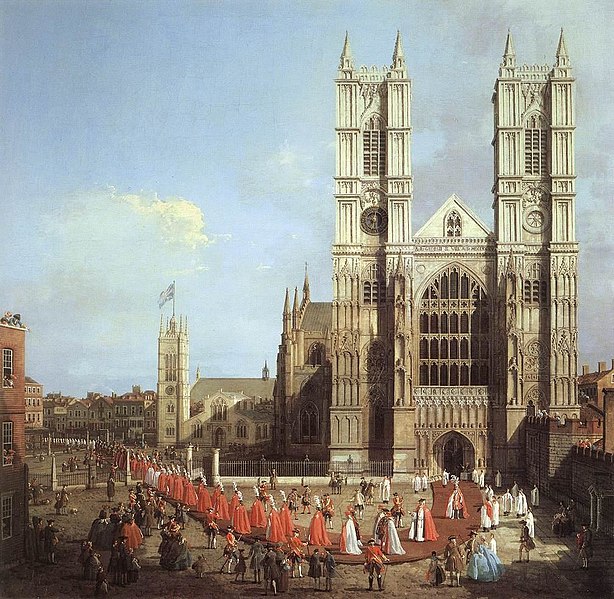Gothic buildings built from the 12th to the 16th century were the biggest source of inspiration to designers in the 19th century. The style first started in France and was quickly taken up by England. Pointed arches, steep - sloping roofs, ribbed vaulting and decorative ornaments and plant decorations (rose windows) that were added to give the tree-like look of the interiors are the characteristics of the Gothic buildings. This style was used when building the Canterbury and Winchester Cathedrals and Westminster Abbey - where the royal corotanions took place.
The Westminster Abbey
This is the highest Gothic building in England, nearly 102 feet tall. It dates from the reign of King Henry III. He laid the foundation stone for a new Lady Chapel in 1220. Because of the Abbey's finantial resources were not sufficient, the rebuilding of the whole church could not be continued. In 1245 Henry pulled down the eastern part of the 11th century Abbey - which had been founded by King Edward. Later, Henry wanted to build a more magnificent church in the New Gothic style, in devotion to St Edward. Masons Henry of Reyns, John of Gloucester and Robert of Beverly supervised the work. Henry of Reyns was highly influenced by chatedrals in Reims and Amiens. It was designed on the sistem of geometrical proportion. Gothic features used when building the Westmister Abbey were: pointed arches, ribbed vaulting, flying buttresses and rose windows. English features were: single aisles (rather than double), a long nave with wide projecting transepts and elaborate mouldings of the main arches.
By 1272, when Henry III died, only one bay of the nave beyond the choir screen had been completed. The old Norman nave remained attached to the Gothic building for over a century - until the 14th century when more money was avalible. Nicholas Litlyngton used Cardinal Simon Langham's money for the western section, and for the next 150 years the work slowly progressed. Litlyngton insisted that Henry III's masons design should be followed. Mason Henry Yevele made a few minor changes in the architectural design that can be seen (on the rosette and diaper).
Henry V was buried at the eastern end of the St Edward's Chapel in 1422. In accordance with his will a lavishly sculptured chantry chapel was built over the tomb with two staircases leading to an altar above.
Between 1503 and 1519, Henry VII added a new Lady Chapel, to replace the one from the 13th century. The Perpendicular architecture of the chapel was in total contrast with tre rest of the Abbey. It has been called "One of the most perfect buildings ever erected in England" and "The wonder of the world" and Henry spent a fortune on its decoration. All around the chapel are Tudor emblems and there are nearly hundred statues of saints around the walls.
By 1530 everything but the top parts of the west towers remained unfinished.
In 1745 the last phase of building was completed - the West Towers in Portland stone. The designer was Nicholas Hawksmoor.

Westminster Abbey with a procession of Knights of the Bath, London
Landscape
Oil on canvas
Painting by: Giovanni Canaletto, 1749.
(source: http://commons.wikimedia.org/wiki/File:Westminster_Abbey_by_Canaletto,_1749.jpg)
Princess Victoria became Queen on June 20th 1837, when her uncle, Kinf William IV died. The coronation was held at Westminster Abbey on June "8th 1838. It was a huge occasion and 400 000 people went to london to see her being crowned.
http://www.westminster-abbey.org/our-history/architecture
http://www.vam.ac.uk/content/articles/s/style-guide-gothic-revival/
http://www.vam.ac.uk/content/articles/g/gothic-architecture/
http://www.royal.gov.uk/The%20Royal%20Collection%20and%20other%20collections/TheRoyalArchives/QueenVictoriaeducationproject/QueenVictoriasCoronation1838.aspx
reference found on Jan 30th 2015
http://www.royal.gov.uk/The%20Royal%20Collection%20and%20other%20collections/TheRoyalArchives/QueenVictoriaeducationproject/QueenVictoriasCoronation1838.aspx
reference found on Jan 30th 2015
Nema komentara:
Objavi komentar